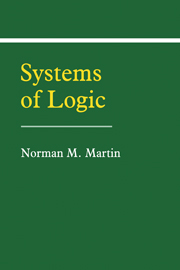Book contents
- Frontmatter
- Contents
- Preface
- 1 Formal Systems and Structure Theory
- 2 Zero-Order Logic: Proof Theory
- 3 Zero-Order Model Theory
- 4 Positive Implication
- 5 Negation
- 6 Complete Implication-Negation Logic
- 7 Disjunction
- 8 Conjunction
- 9 Multi-Connective Systems
- 10 Strict Implications: Introduction
- 11 Strict Implications: Additional Results
- 12 Quantification and First-Order Logic
- 13 Quantification and Complete Logics
- 14 Quantification and Incomplete Logics
- 15 Interpretation of Formal Systems
- Appendix: Historical and Bibliographical Remarks
- Subject Index
- Index of Systems
- Index of Symbols
- Frontmatter
- Contents
- Preface
- 1 Formal Systems and Structure Theory
- 2 Zero-Order Logic: Proof Theory
- 3 Zero-Order Model Theory
- 4 Positive Implication
- 5 Negation
- 6 Complete Implication-Negation Logic
- 7 Disjunction
- 8 Conjunction
- 9 Multi-Connective Systems
- 10 Strict Implications: Introduction
- 11 Strict Implications: Additional Results
- 12 Quantification and First-Order Logic
- 13 Quantification and Complete Logics
- 14 Quantification and Incomplete Logics
- 15 Interpretation of Formal Systems
- Appendix: Historical and Bibliographical Remarks
- Subject Index
- Index of Systems
- Index of Symbols
Summary
We shall now consider systems which extend PI by including a second connective, this time one that takes one argument. This connective is suggested by the ordinary word “not.” As in the case of ⊃, its properties in each system are precisely those given by the rules of the system; the degree to which it otherwise corresponds to the usage of “not” will not interest us in our systematic considerations. It is our intention, however, to introduce a series of systems with progressively greater specification of the connective (which we symbolize by ∼). As a first step, then, we wish to introduce the weakest plausible negation consistent with PI. Here we are helped by the relation between negation and what is sometimes referred to as “absurdity” (sometimes also as “inconsistency”). One of our strongest presystematic agreements concerning negation is that the result of simultaneously asserting a sentence A and its negation ∼ A is absurdity. In this connection, it is irrelevant as to which sentence we started from. There does appear to be a minority intuition, namely, that A and not-A is very different from B and not-B; this however appears to be correlated with a strong rejection of positive implication and we will not consider it at the present time.
- Type
- Chapter
- Information
- Systems of Logic , pp. 72 - 90Publisher: Cambridge University PressPrint publication year: 1989



